Bacterial Diversity in Sediments from Lianhuan Lake, Northeast China
Abstract
:1. Introduction
2. Materials and Methods
2.1. Study Area
2.2. Sediment and Water Sampling
2.3. DNA Extraction, PCR Amplification, and MiSeq Sequencing
2.4. Bioinformatics and Statistical Analyses
3. Results
3.1. Water and Sedimental Physicochemical Characteristics
3.2. Bacterial Diversity in the Sediments of Different Lakes
3.3. Bacterial Community Composition in the Sediments of Different Lakes
3.4. Relationships between Sediment Bacterial Communities and Environmental Factors
4. Discussion
4.1. Variations in the Structure of Sediment Bacterial Communities in Different Lakes
4.2. Relationships between Sediment Bacterial Communities and Physicochemical Properties of Sediment and Water
5. Conclusions
Supplementary Materials
Author Contributions
Funding
Data Availability Statement
Conflicts of Interest
References
- Parparov, A.; Gal, G. Quantifying Ecological Stability: From Community to the Lake Ecosystem. Ecosystems 2017, 20, 1015–1028. [Google Scholar] [CrossRef]
- Van Meerbeek, K.; Jucker, T.; Svenning, J.-C. Unifying the Concepts of Stability and Resilience in Ecology. J. Ecol. 2021, 109, 3114–3132. [Google Scholar] [CrossRef]
- Liu, S.; Yu, H.; Yu, Y.; Huang, J.; Zhou, Z.; Zeng, J.; Chen, P.; Xiao, F.; He, Z.; Yan, Q. Ecological Stability of Microbial Communities in Lake Donghu Regulated by Keystone Taxa. Ecol. Indic. 2022, 136, 108695. [Google Scholar] [CrossRef]
- Fried-Petersen, H.B.; Araya-Ajoy, Y.G.; Futter, M.N.; Angeler, D.G. Drivers of Long-Term Invertebrate Community Stability in Changing Swedish Lakes. Glob. Chang. Biol. 2020, 26, 1259–1270. [Google Scholar] [CrossRef]
- Petchey, O.L.; Gaston, K.J. Functional Diversity (FD), Species Richness and Community Composition. Ecol. Lett. 2002, 5, 402–411. [Google Scholar] [CrossRef]
- Ives, A.R.; Carpenter, S.R. Stability and Diversity of Ecosystems. Science 2007, 317, 58–62. [Google Scholar] [CrossRef]
- van Elsas, J.D.; Chiurazzi, M.; Mallon, C.A.; Elhottova, D.; Kristufek, V.; Salles, J.F. Microbial Diversity Determines the Invasion of Soil by a Bacterial Pathogen. Proc. Natl. Acad. Sci. USA 2012, 109, 1159–1164. [Google Scholar] [CrossRef]
- Wagg, C.; Schlaeppi, K.; Banerjee, S.; Kuramae, E.E.; van der Heijden, M.G.A. Fungal-Bacterial Diversity and Microbiome Complexity Predict Ecosystem Functioning. Nat. Commun. 2019, 10, 4841. [Google Scholar] [CrossRef]
- Yang, X.; Zhu, K.; Loik, M.E.; Sun, W. Differential Responses of Soil Bacteria and Fungi to Altered Precipitation in a Meadow Steppe. Geoderma 2021, 384, 114812. [Google Scholar] [CrossRef]
- Njagi, D.M.; Routh, J.; Odhiambo, M.; Luo, C.; Basapuram, L.G.; Olago, D.; Klump, V.; Stager, C. A Century of Human-Induced Environmental Changes and the Combined Roles of Nutrients and Land Use in Lake Victoria Catchment on Eutrophication. Sci. Total Environ. 2022, 835, 155425. [Google Scholar] [CrossRef] [PubMed]
- Ge, Y.; Zhang, Q.; Dong, X.; Yang, X. Revealing Anthropogenic Effects on Lakes and Wetlands: Pollen-Based Environmental Changes of Liangzi Lake, China over the Last 150 Years. Catena 2021, 207, 105605. [Google Scholar] [CrossRef]
- Du, N.; Ottens, H.; Sliuzas, R. Spatial Impact of Urban Expansion on Surface Water Bodies—A Case Study of Wuhan, China. Landsc. Urban Plan. 2010, 94, 175–185. [Google Scholar] [CrossRef]
- Smol, J.P.; Wolfe, A.P.; Birks, H.J.B.; Douglas, M.S.V.; Jones, V.J.; Korhola, A.; Pienitz, R.; Rühland, K.; Sorvari, S.; Antoniades, D.; et al. Climate-Driven Regime Shifts in the Biological Communities of Arctic Lakes. Proc. Natl. Acad. Sci. USA 2005, 102, 4397–4402. [Google Scholar] [CrossRef]
- Kafumbata, D.; Jamu, D.; Chiotha, S. Riparian Ecosystem Resilience and Livelihood Strategies under Test: Lessons from Lake Chilwa in Malawi and Other Lakes in Africa. Philos. Trans. R. Soc. B Biol. Sci. 2014, 369, 20130052. [Google Scholar] [CrossRef]
- Chon, H.-S.; Ohandja, D.-G.; Voulvoulis, N. The Role of Sediments as a Source of Metals in River Catchments. Chemosphere 2012, 88, 1250–1256. [Google Scholar] [CrossRef]
- Shao, K.; Zhang, L.; Ba, T.; Chao, J.; Gao, G. Bacterial Community Composition of the Sediment in Sayram Lake, an Alpine Lake in the Arid Northwest of China. BMC Microbiol. 2023, 23, 47. [Google Scholar] [CrossRef]
- Yue, Y.; Yang, Z.; Wang, F.; Chen, X.; Huang, Y.; Ma, J.; Cai, L.; Yang, M. Effects of Cascade Reservoirs on Spatiotemporal Dynamics of the Sedimentary Bacterial Community: Co-Occurrence Patterns, Assembly Mechanisms, and Potential Functions. Microb. Ecol. 2024, 87, 18. [Google Scholar] [CrossRef]
- Langenheder, S.; Lindström, E.S. Factors Influencing Aquatic and Terrestrial Bacterial Community Assembly. Environ. Microbiol. Rep. 2019, 11, 306–315. [Google Scholar] [CrossRef] [PubMed]
- Kraemer, S.A.; Barbosa da Costa, N.; Shapiro, B.J.; Fradette, M.; Huot, Y.; Walsh, D.A. A Large-Scale Assessment of Lakes Reveals a Pervasive Signal of Land Use on Bacterial Communities. ISME J. 2020, 14, 3011–3023. [Google Scholar] [CrossRef]
- Yannarell, A.C.; Triplett, E.W. Within- and between-Lake Variability in the Composition of Bacterioplankton Communities: Investigations Using Multiple Spatial Scales. Appl. Environ. Microbiol. 2004, 70, 214–223. [Google Scholar] [CrossRef]
- Dou, Q.; Du, X.; Cong, Y.; Wang, L.; Zhao, C.; Song, D.; Liu, H.; Huo, T. Influence of Environmental Variables on Macroinvertebrate Community Structure in Lianhuan Lake. Ecol. Evol. 2022, 12, e8553. [Google Scholar] [CrossRef] [PubMed]
- Sun, Y.; Li, X.; Liu, J.; Yao, Q.; Jin, J.; Liu, X.; Wang, G. Comparative Analysis of Bacterial Community Compositions between Sediment and Water in Different Types of Wetlands of Northeast China. J. Soils Sediments 2019, 19, 3083–3097. [Google Scholar] [CrossRef]
- Sun, J.; Cong, Y.; Wang, H.; Zhao, C.; Wang, L.; Song, D.; Huang, X.; Dou, Q.; Huo, T. Structure of Zooplankton Community and Its Influence Factors in Tiehala Lake of Lianhuan Lake. Wetl. Sci. 2023, 21, 403–413. [Google Scholar] [CrossRef]
- Chen, X. Characteristics of Plankton Community Structure and Evaluation Onhydroecological Status of Two Waters of Lianhuan Lake. Master‘s Thesis, Shanghai Ocean University, Shanghai, China, 2021. [Google Scholar]
- Dou, Q.; Du, X.; Wang, L.; Song, D.; Zhao, C.; Huang, X.; Wang, H.; Huo, T. Effects of land use and aquatic environmental factors on secondary productivity of macroinvertebrates:A case of Lake Lianhuan Group, northeast China. J. Lake Sci. 2024, 36, 846–857. [Google Scholar] [CrossRef]
- Chao, C.; Wang, L.; Li, Y.; Yan, Z.; Liu, H.; Yu, D.; Liu, C. Response of Sediment and Water Microbial Communities to Submerged Vegetations Restoration in a Shallow Eutrophic Lake. Sci. Total Environ. 2021, 801, 149701. [Google Scholar] [CrossRef]
- Zhang, R.; Sun, M.; Zhang, H.; Zhao, Z. Spatial Separation of Microbial Communities Reflects Gradients of Salinity and Temperature in Offshore Sediments from Shenzhen, South China. Ocean. Coast. Manag. 2021, 214, 105904. [Google Scholar] [CrossRef]
- Liu, L.; Yang, J.; Yu, Z.; Wilkinson, D.M. The Biogeography of Abundant and Rare Bacterioplankton in the Lakes and Reservoirs of China. ISME J. 2015, 9, 2068–2077. [Google Scholar] [CrossRef] [PubMed]
- Gales, M.E., Jr.; Julian, E.C.; Kroner, R.C. Method for Quantitative Determination of Total Phosphorus in Water. J. AWWA 1966, 58, 1363–1368. [Google Scholar] [CrossRef]
- Sasongko, A. Ammonia Determination In Bottled Water Using Spectrophotometer: Comparison Between Nessler And Berthelot Methods. JST (J. Sains Dan Teknol.) 2018, 7, 126–134. [Google Scholar] [CrossRef]
- Armstrong, F.A.J. Determination of Nitrate in Water Ultraviolet Spectrophotometry. Anal. Chem. 1963, 35, 1292–1294. [Google Scholar] [CrossRef]
- Nagaraja, P.; Shivaswamy, M.; Kumar, H. Highly Sensitive N-(1-Naphthyl)Ethylene Diamine Method for the Spectrophotometric Determination of Trace Amounts of Nitrite in Various Water Samples. Int. J. Environ. Anal. Chem. 2001, 80, 39–48. [Google Scholar] [CrossRef]
- Jeffrey, S.T.; Humphrey, G.F. New Spectrophotometric Equations for Determining Chlorophylls a, b, C1 and C2 in Higher Plants, Algae and Natural Phytoplankton. Biochem. Und Physiol. Der Pflanz. 1975, 167, 191–194. [Google Scholar] [CrossRef]
- Adjovu, G.E.; Stephen, H.; James, D.; Ahmad, S. Measurement of Total Dissolved Solids and Total Suspended Solids in Water Systems: A Review of the Issues, Conventional, and Remote Sensing Techniques. Remote Sens. 2023, 15, 3534. [Google Scholar] [CrossRef]
- Chin-Ping, G.; Poh-Eng, L. Potassium permanganate as oxidant in the cod test for saline water samples. ASEAN J. Sci. Technol. Dev. 2017, 25, 383–393. [Google Scholar] [CrossRef]
- Pu, H.; Yuan, Y.; Qin, L.; Liu, X. pH Drives Differences in Bacterial Community β-Diversity in Hydrologically Connected Lake Sediments. Microorganisms 2023, 11, 676. [Google Scholar] [CrossRef] [PubMed]
- Chen, W.; Wei, J.; Su, Z.; Wu, L.; Liu, M.; Huang, X.; Yao, P.; Wen, D. Deterministic Mechanisms Drive Bacterial Communities Assembly in Industrial Wastewater Treatment System. Environ. Int. 2022, 168, 107486. [Google Scholar] [CrossRef]
- Gao, Y.; Zhang, W.; Li, Y. Microbial Community Coalescence: Does It Matter in the Three Gorges Reservoir? Water Res. 2021, 205, 117638. [Google Scholar] [CrossRef]
- Liu, L.; Li, C.; Li, H. Long-Term Microbial Community Succession and Mechanisms of Regulation of Dissolved Organic Matter Derivation in Livestock Manure Fermentation System. Chemosphere 2023, 329, 138588. [Google Scholar] [CrossRef]
- Callahan, B.J.; McMurdie, P.J.; Rosen, M.J.; Han, A.W.; Johnson, A.J.; Holmes, S.P. DADA2: High Resolution Sample Inference from Amplicon Data. bioRxiv 2015. [Google Scholar] [CrossRef]
- Oren, A.; Garrity, G.M. Valid Publication of the Names of Forty-Two Phyla of Prokaryotes. Int. J. Syst. Evol. Microbiol. 2021, 71, 005056. [Google Scholar] [CrossRef]
- Wang, K.; Ye, X.; Chen, H.; Zhao, Q.; Hu, C.; He, J.; Qian, Y.; Xiong, J.; Zhu, J.; Zhang, D. Bacterial Biogeography in the Coastal Waters of Northern Zhejiang, East China Sea Is Highly Controlled by Spatially Structured Environmental Gradients. Environ. Microbiol. 2015, 17, 3898–3913. [Google Scholar] [CrossRef] [PubMed]
- Yu, B.; Zeng, Q.; Li, J.; Li, J.; Tan, X.; Gao, X.; Huang, P.; Wu, S. Vertical Variation in Prokaryotic Community Composition and Co-Occurrence Patterns in Sediments of the Three Gorges Reservoir, China. Environ. Res. 2023, 237, 116927. [Google Scholar] [CrossRef] [PubMed]
- Liu, C.; Cui, Y.; Li, X.; Yao, M. Microeco: An R Package for Data Mining in Microbial Community Ecology. FEMS Microbiol. Ecol. 2021, 97, fiaa255. [Google Scholar] [CrossRef] [PubMed]
- Huang, H. linkET: Everything Is Linkable, R Package Version 0.0.3. 2021. Available online: https://github.com/Hy4m/linkET (accessed on 18 July 2024).
- Cotner, J.B.; Biddanda, B.A. Small Players, Large Role: Microbial Influence on Biogeochemical Processes in Pelagic Aquatic Ecosystems. Ecosystems 2002, 5, 105–121. [Google Scholar] [CrossRef]
- Chakraborty, S.K. Trophic Interactions and Biogeochemical Cycles in River Ecosystem. In Riverine Ecology; Springer: Cham, Switzerland, 2021; Volume 1, pp. 167–234. ISBN 978-3-030-53897-2. [Google Scholar]
- Williams, C.J.; Frost, P.C.; Morales-Williams, A.M.; Larson, J.H.; Richardson, W.B.; Chiandet, A.S.; Xenopoulos, M.A. Human Activities Cause Distinct Dissolved Organic Matter Composition across Freshwater Ecosystems. Glob. Chang. Biol. 2016, 22, 613–626. [Google Scholar] [CrossRef]
- Song, D.; Huo, T.; Zhang, Z.; Cheng, L.; Wang, L.; Ming, K.; Liu, H.; Li, M.; Du, X. Metagenomic Analysis Reveals the Response of Microbial Communities and Their Functions in Lake Sediment to Environmental Factors. Int. J. Environ. Res. Public Health 2022, 19, 16870. [Google Scholar] [CrossRef]
- McCormick, A.R.; Phillips, J.S.; Ives, A.R. Responses of Benthic Algae to Nutrient Enrichment in a Shallow Lake: Linking Community Production, Biomass, and Composition. Freshw. Biol. 2019, 64, 1833–1847. [Google Scholar] [CrossRef]
- Martínez-López, A.; Escobedo-Urías, D.; Reyes-Salinas, A.; Hernández-Real, M.T. Phytoplankton Response to Nutrient Runoff in a Large Lagoon System in the Gulf of California. Hidrobiológica 2007, 17, 101–112. [Google Scholar]
- Zhou, M.; Shen, Z.; Yu, R. Responses of a Coastal Phytoplankton Community to Increased Nutrient Input from the Changjiang (Yangtze) River. Cont. Shelf Res. 2008, 28, 1483–1489. [Google Scholar] [CrossRef]
- Song, Z.; Zou, W.; Gui, Z.; Xu, H.; Cai, Y. Common-used trophic level index in Chinese lakes: Progress and prospects. J. Lake Sci. 2024, 36, 987–1001. [Google Scholar]
- Kasprzak, P.; Padisák, J.; Koschel, R.; Krienitz, L.; Gervais, F. Chlorophyll a Concentration across a Trophic Gradient of Lakes: An Estimator of Phytoplankton Biomass? Limnologica 2008, 38, 327–338. [Google Scholar] [CrossRef]
- Boyer, J.N.; Kelble, C.R.; Ortner, P.B.; Rudnick, D.T. Phytoplankton Bloom Status: Chlorophyll a Biomass as an Indicator of Water Quality Condition in the Southern Estuaries of Florida, USA. Ecol. Indic. 2009, 9, S56–S67. [Google Scholar] [CrossRef]
- Devlin, M.; Brodie, J. Nutrients and Eutrophication. In Marine Pollution—Monitoring, Management and Mitigation; Reichelt-Brushett, A., Ed.; Springer Nature: Cham, Switzerland, 2023; pp. 75–100. ISBN 978-3-031-10127-4. [Google Scholar]
- Akinnawo, S.O. Eutrophication: Causes, Consequences, Physical, Chemical and Biological Techniques for Mitigation Strategies. Environ. Chall. 2023, 12, 100733. [Google Scholar] [CrossRef]
- Shao, K.; Gao, G.; Qin, B.-Q.; Tang, X.; Wang, Y.; Chi, K.; Dai, J. Comparing Sediment Bacterial Communities in the Macrophyte-Dominated and Algae-Dominated Areas of Eutrophic Lake Taihu, China. Can. J. Microbiol. 2011, 57, 263–272. [Google Scholar] [CrossRef] [PubMed]
- Zaitseva, S.V.; Abidueva, E.Y.; Namsaraev, B.B.; Wang, L.; Wu, L. Microbial Community of the Bottom Sediments of the Brackish Lake Beloe (Transbaikal Region). Microbiology 2014, 83, 861–868. [Google Scholar] [CrossRef]
- Zhang, L.; Gao, G.; Tang, X.; Shao, K.; Gong, Y. Pyrosequencing Analysis of Bacterial Communities in Lake Bosten, a Large Brackish Inland Lake in the Arid Northwest of China. Can. J. Microbiol. 2016, 62, 455–463. [Google Scholar] [CrossRef]
- Legrand, T.P.R.A.; Catalano, S.R.; Wos-Oxley, M.L.; Stephens, F.; Landos, M.; Bansemer, M.S.; Stone, D.A.J.; Qin, J.G.; Oxley, A.P.A. The Inner Workings of the Outer Surface: Skin and Gill Microbiota as Indicators of Changing Gut Health in Yellowtail Kingfish. Front. Microbiol. 2017, 8, 2664. [Google Scholar] [CrossRef]
- Yi, Y.; Lin, C.; Wang, W.; Song, J. Habitat and Seasonal Variations in Bacterial Community Structure and Diversity in Sediments of a Shallow Lake. Ecol. Indic. 2021, 120, 106959. [Google Scholar] [CrossRef]
- Tang, X.; Xie, G.; Shao, K.; Tian, W.; Gao, G.; Qin, B. Aquatic Bacterial Diversity, Community Composition and Assembly in the Semi-Arid Inner Mongolia Plateau: Combined Effects of Salinity and Nutrient Levels. Microorganisms 2021, 9, 208. [Google Scholar] [CrossRef]
- Sagova-Mareckova, M.; Boenigk, J.; Bouchez, A.; Cermakova, K.; Chonova, T.; Cordier, T.; Eisendle, U.; Elersek, T.; Fazi, S.; Fleituch, T.; et al. Expanding Ecological Assessment by Integrating Microorganisms into Routine Freshwater Biomonitoring. Water Res. 2021, 191, 116767. [Google Scholar] [CrossRef]
- Mateo, P.; Leganés, F.; Perona, E.; Loza, V.; Fernández-Piñas, F. Cyanobacteria as Bioindicators and Bioreporters of Environmental Analysis in Aquatic Ecosystems. Biodivers. Conserv. 2015, 24, 909–948. [Google Scholar] [CrossRef]
- Reid, R.P.; Oehlert, A.M.; Suosaari, E.P.; Demergasso, C.; Chong, G.; Escudero, L.V.; Piggot, A.M.; Lascu, I.; Palma, A.T. Electrical Conductivity as a Driver of Biological and Geological Spatial Heterogeneity in the Puquios, Salar de Llamara, Atacama Desert, Chile. Sci. Rep. 2021, 11, 12769. [Google Scholar] [CrossRef] [PubMed]
- Mai, Y.; Peng, S.; Lai, Z.; Wang, X. Saltwater Intrusion Affecting NO2− Accumulation in Demersal Fishery Species by Bacterially Mediated N-Cycling. Sci. Total Environ. 2022, 827, 154371. [Google Scholar] [CrossRef] [PubMed]
- Ji, M.; Kong, W.; Yue, L.; Wang, J.; Deng, Y.; Zhu, L. Salinity Reduces Bacterial Diversity, but Increases Network Complexity in Tibetan Plateau Lakes. FEMS Microbiol. Ecol. 2019, 95, fiz190. [Google Scholar] [CrossRef]
- Yin, Z.; Li, J.; Zhang, B.; Liu, Y.; Yan, K.; Gao, M.; Xie, Y.; Zhang, F.; Wang, S. Increase in Chlorophyll-a Concentration in Lake Taihu from 1984 to 2021 Based on Landsat Observations. Sci. Total Environ. 2023, 873, 162168. [Google Scholar] [CrossRef] [PubMed]
- Kiersztyn, B.; Chróst, R.; Kaliński, T.; Siuda, W.; Bukowska, A.; Kowalczyk, G.; Grabowska, K. Structural and Functional Microbial Diversity along a Eutrophication Gradient of Interconnected Lakes Undergoing Anthropopressure. Sci. Rep. 2019, 9, 11144. [Google Scholar] [CrossRef]
- Crossetti, L.O.; Bicudo, D.C.; Bicudo, C.E.M.; Bini, L.M. Phytoplankton Biodiversity Changes in a Shallow Tropical Reservoir during the Hypertrophication Process. Braz. J. Biol. 2008, 68, 1061–1067. [Google Scholar] [CrossRef]
- Millero, F.J. The Conductivity-density-salinity-chlorinity Relationships for Estuarine Waters1. Limnol. Oceanogr. 1984, 29, 1317–1321. [Google Scholar] [CrossRef]
- Wan, W.; Zhang, Y.; Cheng, G.; Li, X.; Qin, Y.; He, D. Dredging Mitigates Cyanobacterial Bloom in Eutrophic Lake Nanhu: Shifts in Associations between the Bacterioplankton Community and Sediment Biogeochemistry. Environ. Res. 2020, 188, 109799. [Google Scholar] [CrossRef]
- Yang, Y.; Chen, J.; Tong, T.; Li, B.; He, T.; Liu, Y.; Xie, S. Eutrophication Influences Methanotrophic Activity, Abundance and Community Structure in Freshwater Lakes. Sci. Total Environ. 2019, 662, 863–872. [Google Scholar] [CrossRef]
- Fan, Y.-Y.; Li, B.-B.; Yang, Z.-C.; Cheng, Y.-Y.; Liu, D.-F.; Yu, H.-Q. Mediation of Functional Gene and Bacterial Community Profiles in the Sediments of Eutrophic Chaohu Lake by Total Nitrogen and Season. Environ. Pollut. 2019, 250, 233–240. [Google Scholar] [CrossRef] [PubMed]
- Highton, M.P.; Roosa, S.; Crawshaw, J.; Schallenberg, M.; Morales, S.E. Physical Factors Correlate to Microbial Community Structure and Nitrogen Cycling Gene Abundance in a Nitrate Fed Eutrophic Lagoon. Front. Microbiol. 2016, 7, 1691. [Google Scholar] [CrossRef]
- Bouskill, N.J.; Barker-Finkel, J.; Galloway, T.S.; Handy, R.D.; Ford, T.E. Temporal Bacterial Diversity Associated with Metal-Contaminated River Sediments. Ecotoxicology 2010, 19, 317–328. [Google Scholar] [CrossRef]
- Sauvain, L.; Bueche, M.; Junier, T.; Masson, M.; Wunderlin, T.; Kohler-Milleret, R.; Diez, E.; Loizeau, J.-L.; Tercier-Waeber, M.-L.; Junier, P. Bacterial Communities in Trace Metal Contaminated Lake Sediments Are Dominated by Endospore-Forming Bacteria. Aquat. Sci. 2013, 76, 33–46. [Google Scholar] [CrossRef]
- Gupta, S.; Graham, D.W.; Sreekrishnan, T.R.; Ahammad, S.Z. Exploring the Impacts of Physicochemical Characteristics and Heavy Metals Fractions on Bacterial Communities in Four Rivers. J. Environ. Manag. 2023, 325, 116453. [Google Scholar] [CrossRef]
- Cao, X.; Wang, Y.; He, J.; Luo, X.; Zheng, Z. Phosphorus Mobility among Sediments, Water and Cyanobacteria Enhanced by Cyanobacteria Blooms in Eutrophic Lake Dianchi. Environ. Pollut. 2016, 219, 580–587. [Google Scholar] [CrossRef] [PubMed]
- Meng, L.; Zuo, R.; Wang, J.; Yang, J.; Li, Q.; Chen, M. The Spatial Variations of Correlation between Microbial Diversity and Groundwater Quality Derived from a Riverbank Filtration Site, Northeast China. Sci. Total Environ. 2020, 706, 135855. [Google Scholar] [CrossRef]
- Dao, T.-S.; Nimptsch, J.; Wiegand, C. Dynamics of Cyanobacteria and Cyanobacterial Toxins and Their Correlation with Environmental Parameters in Tri An Reservoir, Vietnam. J. Water Health 2016, 14, 699–712. [Google Scholar] [CrossRef]
- Yamamoto, Y.; Nakahara, H. The Formation and Degradation of Cyanobacterium Aphanizomenon Flos-Aquae Blooms: The Importance of pH, Water Temperature, and Day Length. Limnology 2005, 6, 1–6. [Google Scholar] [CrossRef]
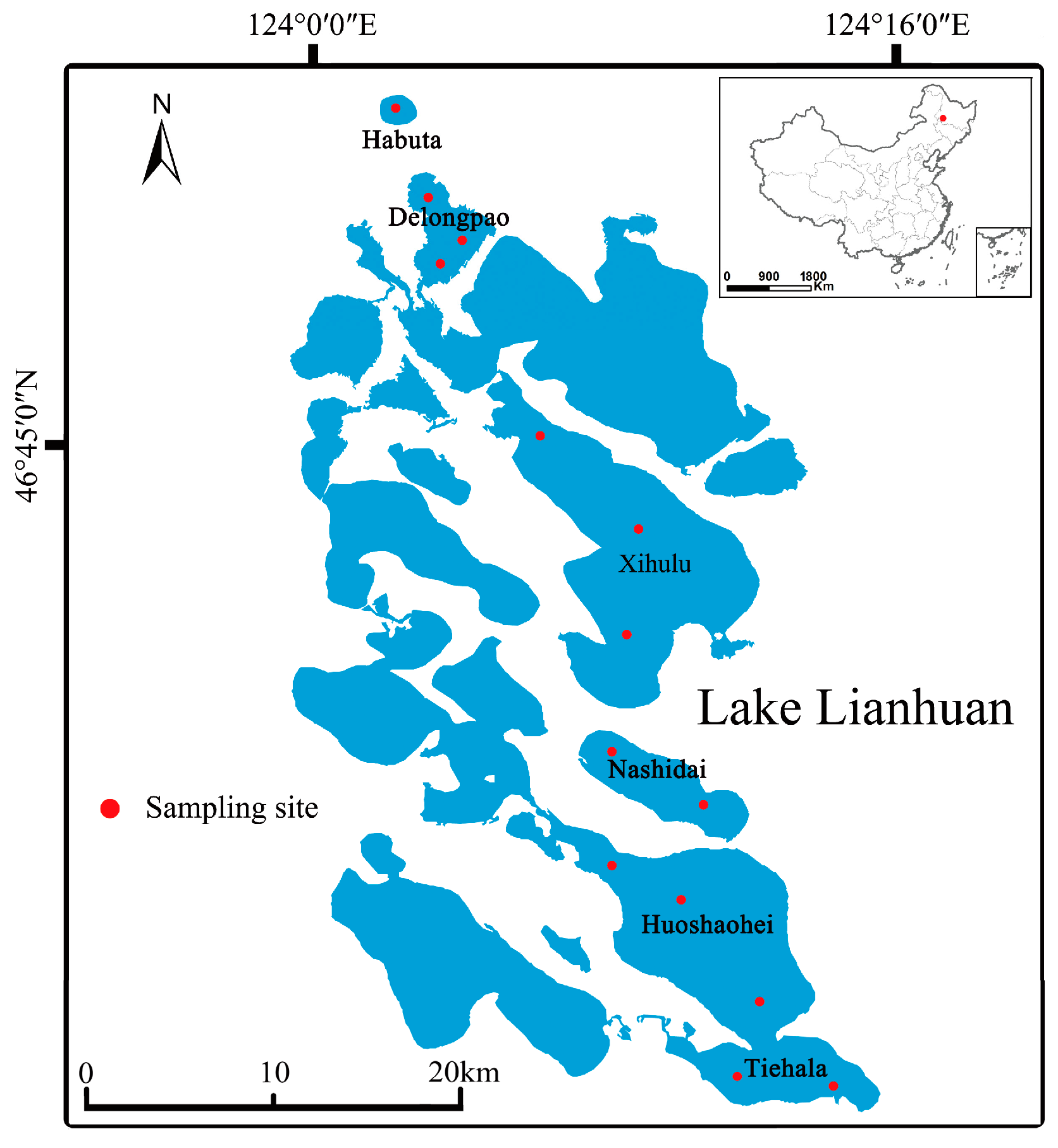
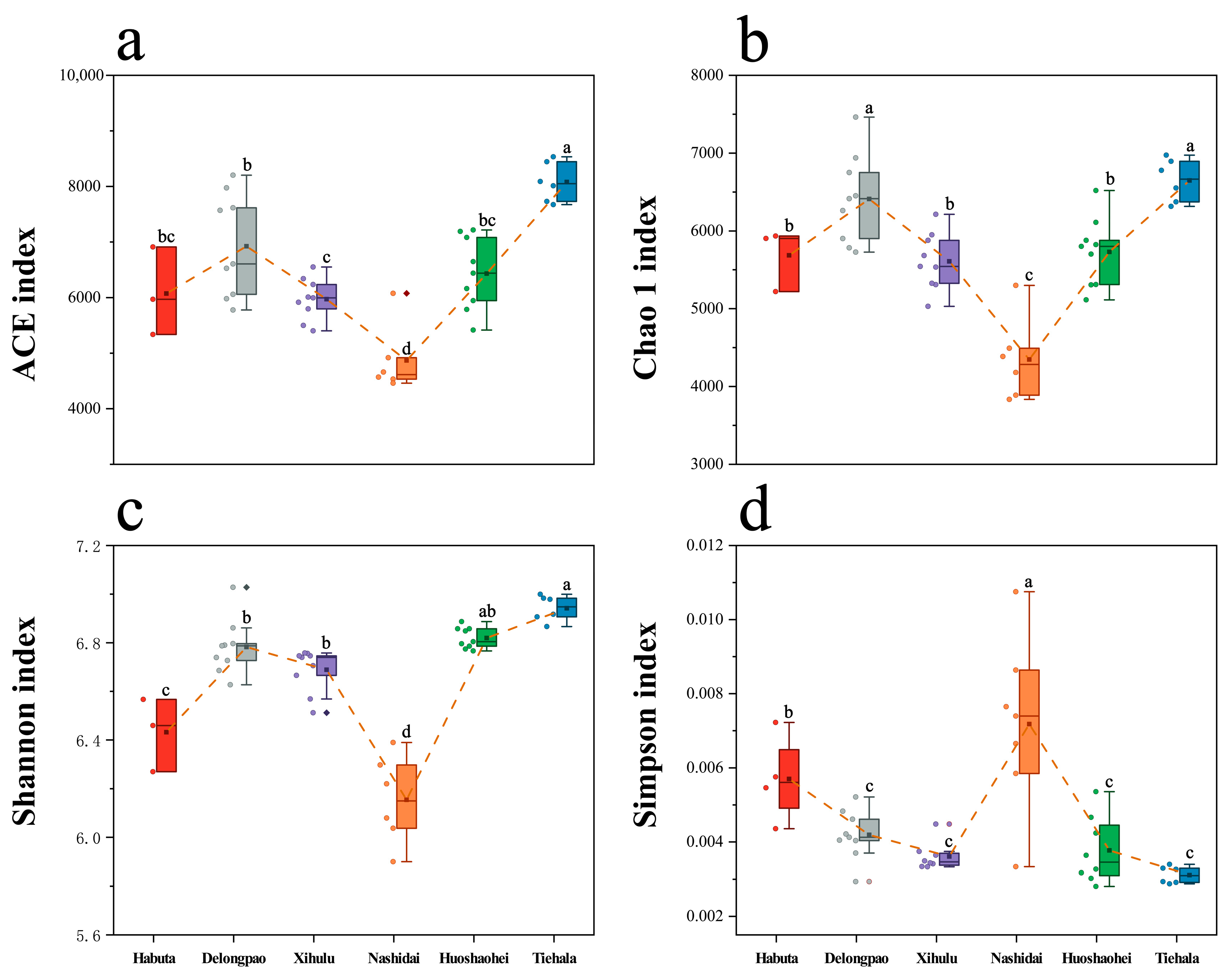
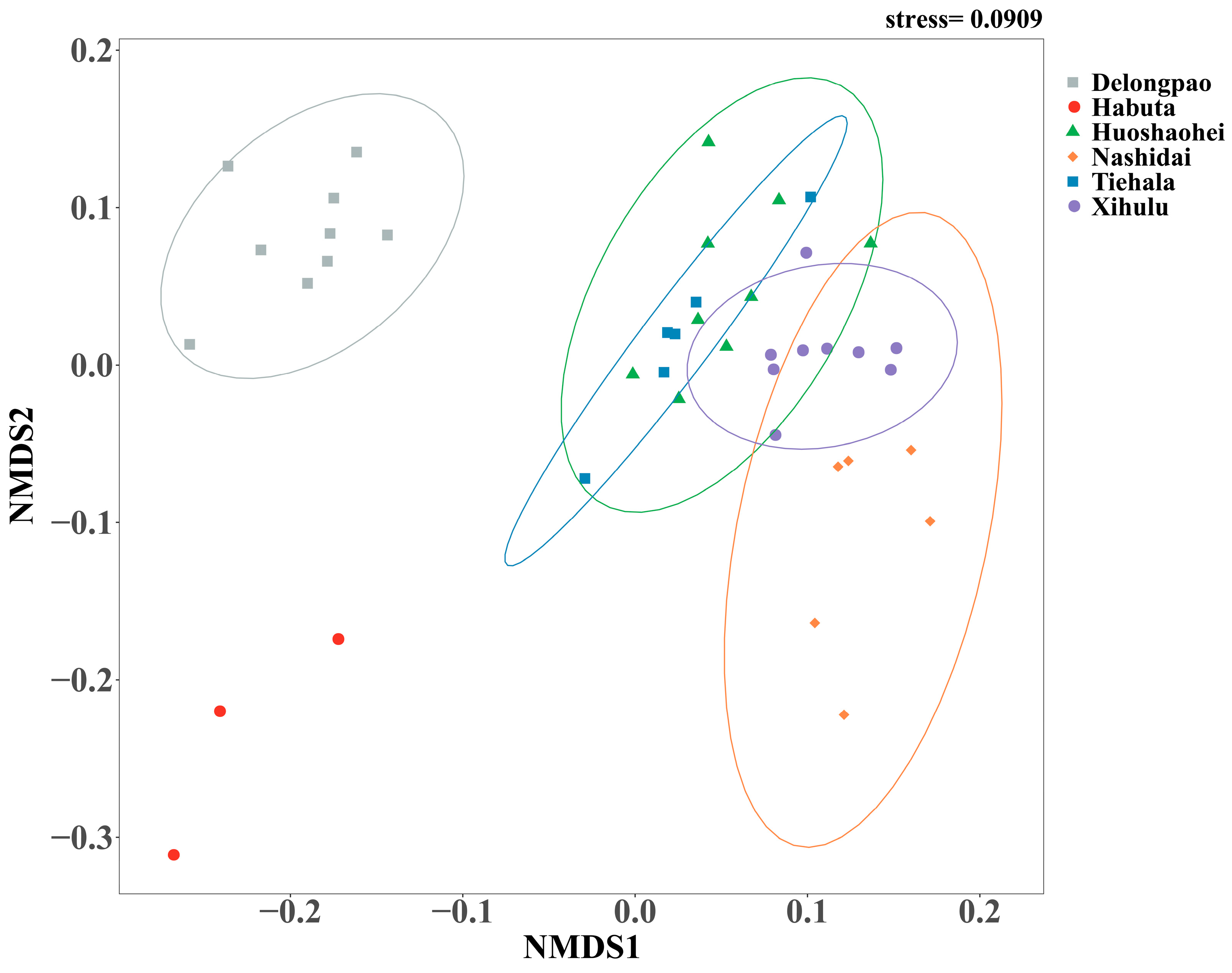
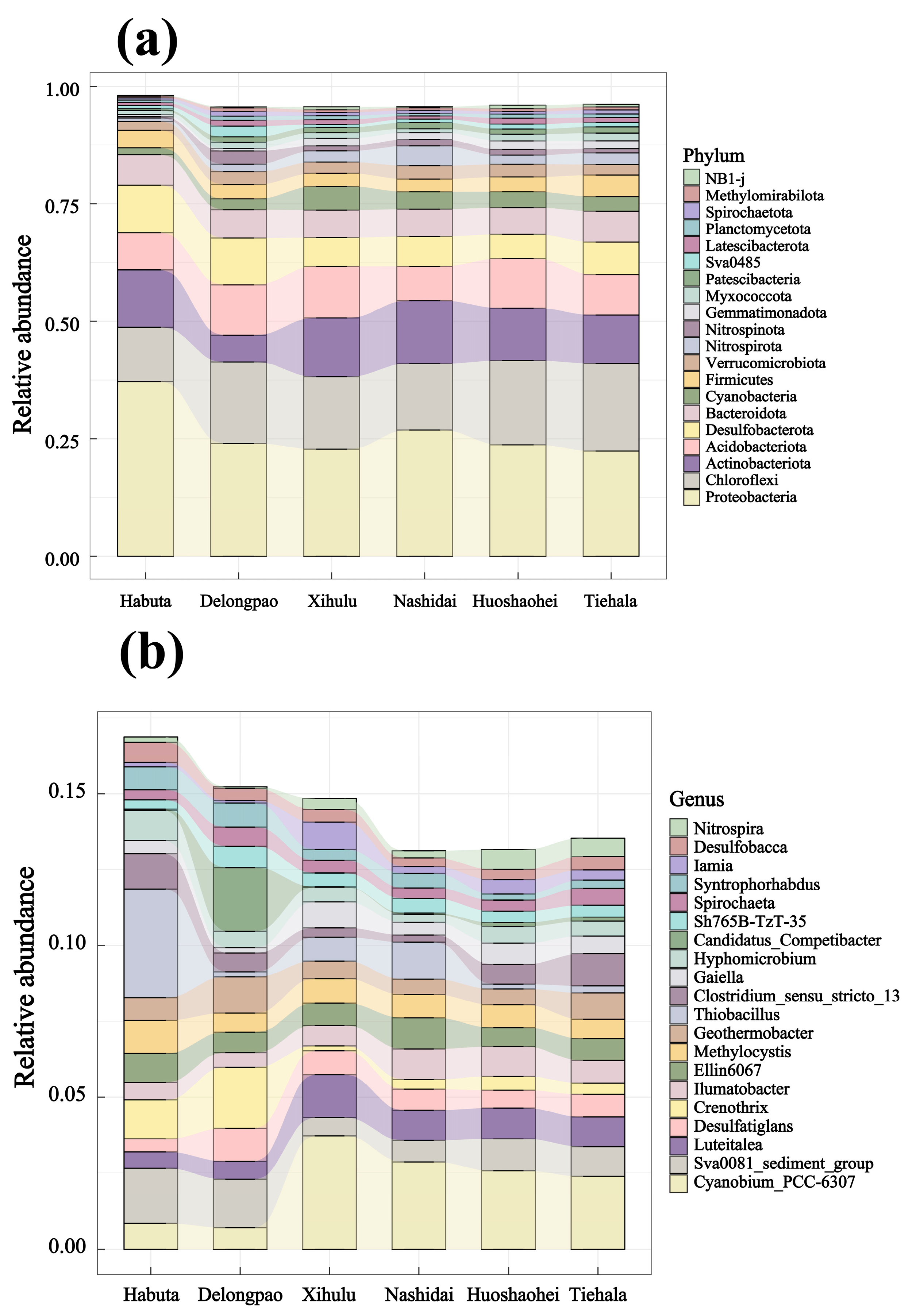
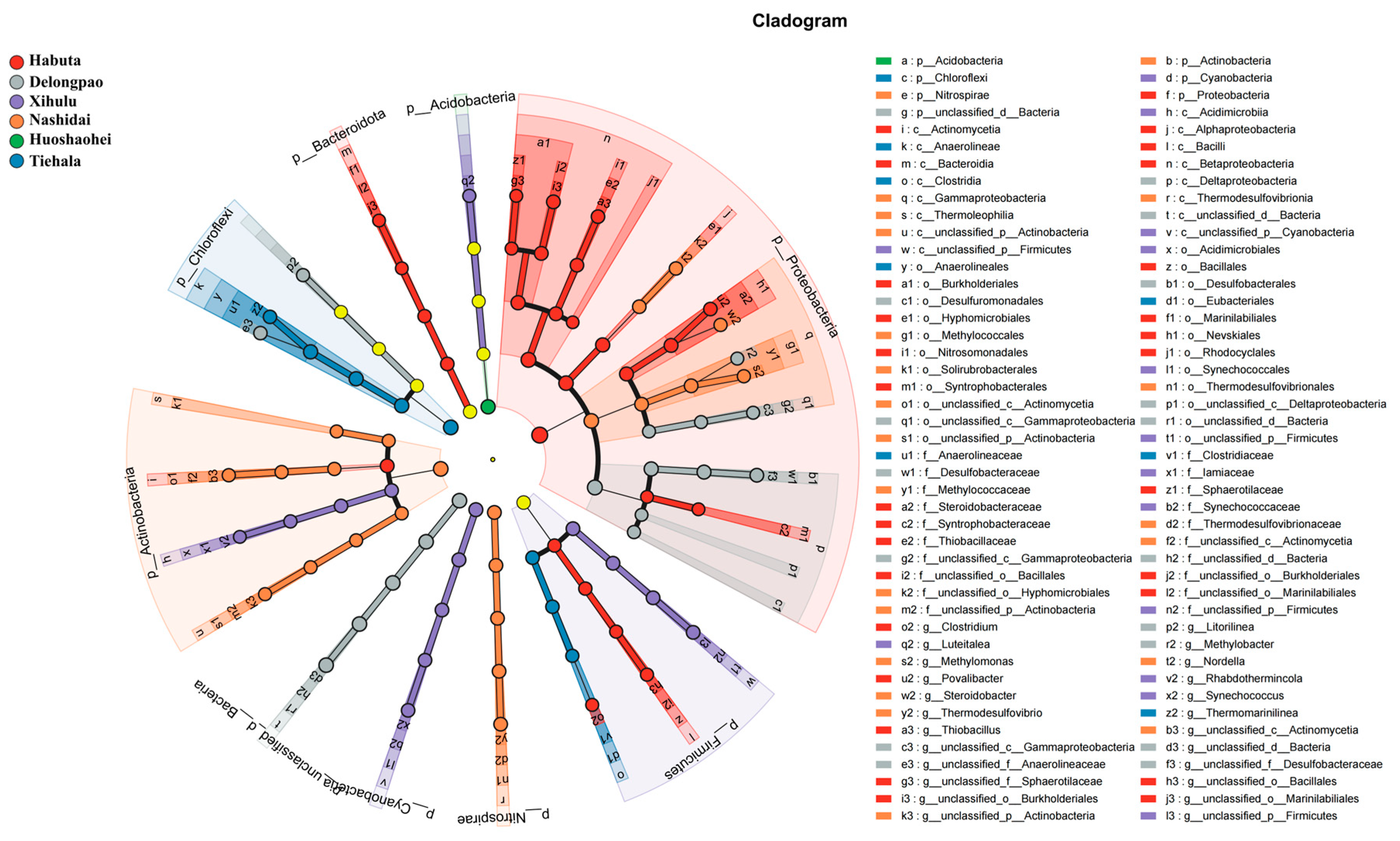
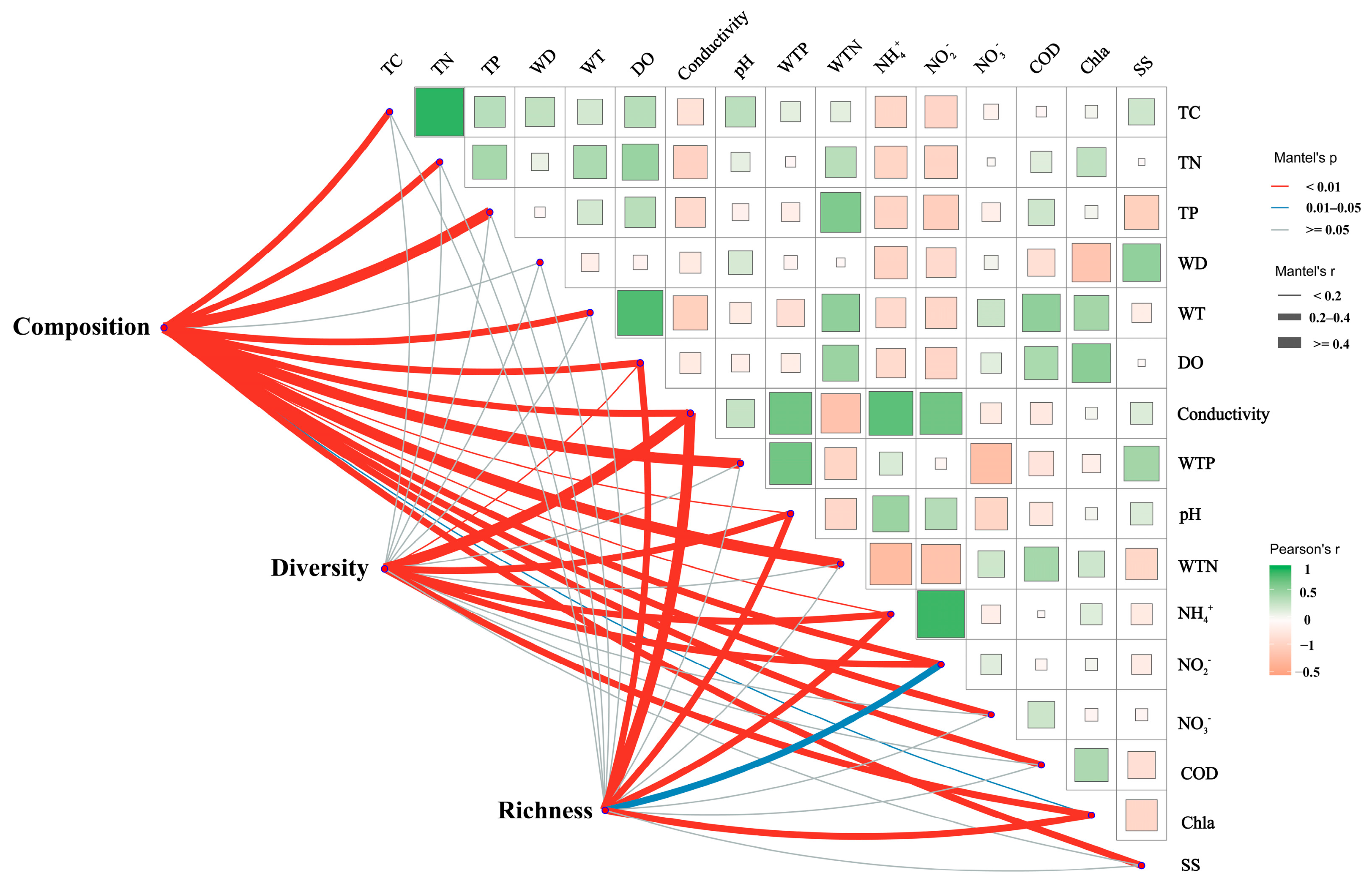

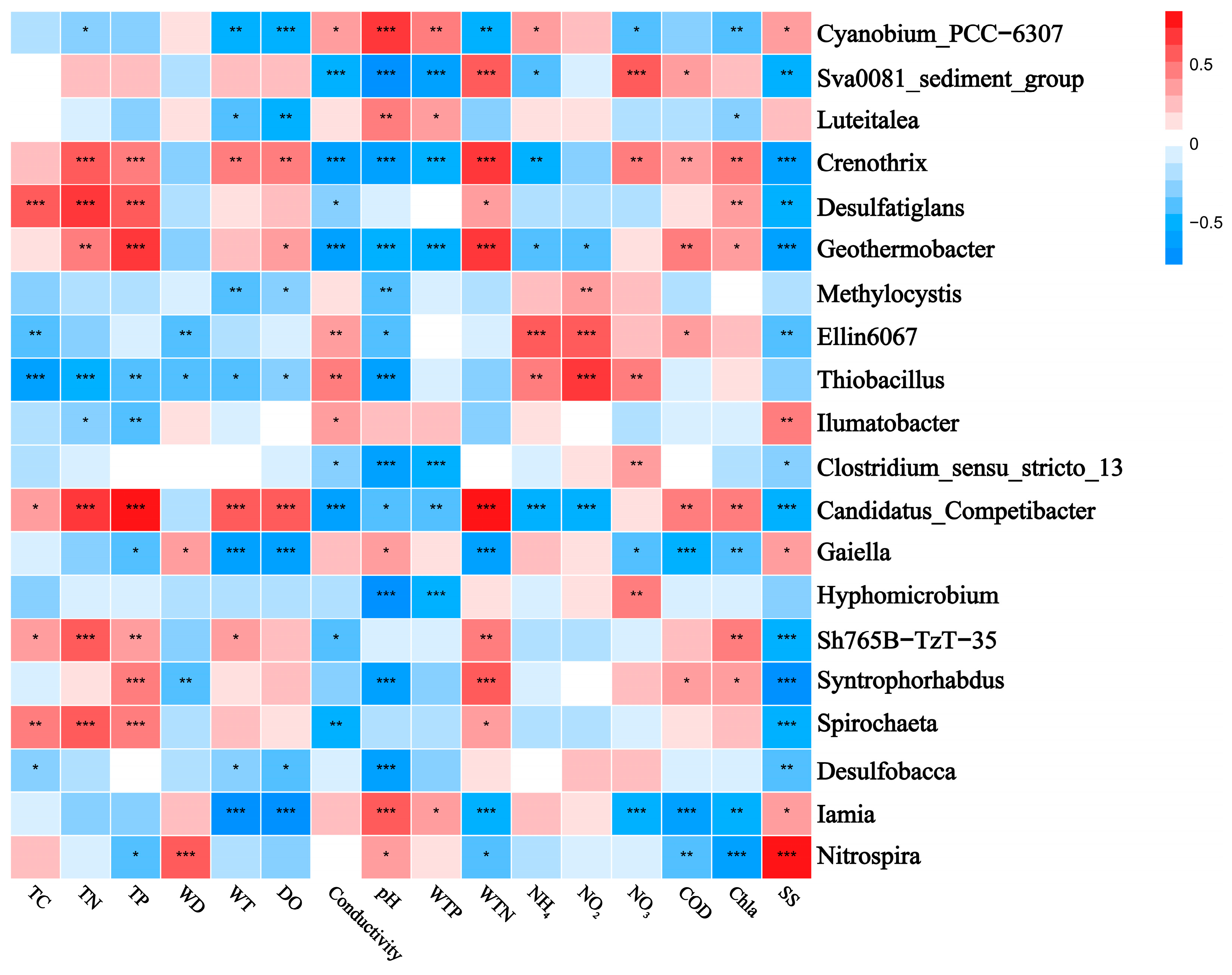

| The Name of the Lake | WT (°C) | DO (mg L−1) | pH | Conductivity (μs cm−1) | COD (mg L−1) | NH4+-N (mg L−1) | WTP (mg L−1) | WTN (mg L−1) | NO2–N (mg L−1) | NO3–N (mg L−1) | Chla (μg L−1) | SS (mg L−1) |
|---|---|---|---|---|---|---|---|---|---|---|---|---|
| Habuta | 22 ± 0.5 b | 7.59 ± 0.02 c | 7.84 ± 0.01 c | 654 ± 1 b | 10 ± 1 a | 1.5 ± 0.01 a | 0.1 ± 0.01 c | 1.48 ± 0.01 b | 0.14 ± 0 a | 0.17 ± 0 a | 16.3 ± 0.01 ab | 11 ± 0 b |
| Delongpao | 24.03 ± 0.95 a | 9.93 ± 0.15 a | 8.44 ± 0.17 b | 531.5 ± 50.1 d | 13.36 ± 1.71 a | 1.01 ± 0.17 c | 0.12 ± 0.01 c | 2.16 ± 0.34 a | 0.07 ± 0.02 c | 0.11 ± 0.01 b | 21.08 ± 4.18 ab | 10.67 ± 3.21 b |
| Xihulu | 21.5 ± 0.1 b | 7.36 ± 0.33 c | 8.89 ± 0.04 a | 657.33 ± 6.03 b | 5.85 ± 0.37 a | 1.43 ± 0.16 a | 0.16 ± 0.03 bc | 1.37 ± 0.28 b | 0.1 ± 0.01 b | 0.06 ± 0.01 c | 15.34 ± 1.61 ab | 16.67 ± 3.06 ab |
| Nashidai | 23.4 a | 9.95 ± 0.92 a | 8.79 ± 0.2 a | 755 ± 1.41 a | 12.14 ± 6.77 a | 1.64 ± 0.13 a | 0.18 ± 0.01 a | 1.45 ± 0.05 b | 0.12 ± 0.01 ab | 0.1 ± 0.02 bc | 21.85 ± 5.63 a | 17.5 ± 0.71 ab |
| Huoshaohei | 23.07 ± 0.15 a | 9.01 ± 0.06 b | 8.71 ± 0.02 a | 596.33 ± 0.58 c | 6.97 ± 1.31 a | 1.03 ± 0.19 bc | 0.13 ± 0.01 c | 1.5 ± 0.16 b | 0.08 ± 0.01 c | 0.1 ± 0.03 bc | 13.16 ± 3.39 c | 24.67 ± 6.51 a |
| Tiehala | 23.3 ± 0.14 a | 8.73 ± 0.18 b | 8.67 ± 0.01 ab | 595 ± 1.41 c | 11.38 ± 7.84 a | 1.36 ± 0.07 ab | 0.13 ± 0.01 bc | 1.43 ± 0.08 b | 0.09 ± 0.01 bc | 0.09 ± 0 bc | 16.56 ± 3.18 ab | 17.5 ± 4.95 ab |
| The Name of the Lake | TC (g/kg) | TN (g/kg) | TP (g/kg) |
|---|---|---|---|
| Habuta | 6.65 ± 0.21 b | 0.61 ± 0.02 c | 0.28 ± 0.04 c |
| Delongpao | 39.15 ± 13.64 a | 3.55 ± 1.23 a | 1.46 ± 0.61 a |
| Xihulu | 28.80 ± 6.78 a | 1.89 ± 0.37 b | 0.78 ± 0.17 b |
| Nashidai | 28.13 ± 1.89 a | 1.96 ± 0.15 b | 0.76 ± 0.13 b |
| Huoshaohei | 34.59 ± 11.16 a | 2.28 ± 0.57 b | 0.66 ± 0.06 bc |
| Tiehala | 29.64 ± 0.87 a | 2.13 ± 0.09 b | 0.76 ± 0.15 b |
| Pairs | R2 | p-Value | p-Adjusted |
|---|---|---|---|
| Habuta vs. Delongpao | 0.6395955 | 0.01 | 0.01154 |
| Habuta vs. Xihulu | 0.6867442 | 0.01 | 0.01154 |
| Habuta vs. Nashidai | 0.6458678 | 0.018 | 0.01929 |
| Habuta vs. Huoshaohei | 0.5856005 | 0.005 | 0.00750 |
| Habuta vs. Tiehala | 0.6683037 | 0.009 | 0.01154 |
| Delongpao vs. Xihulu | 0.7043276 | 0.001 | 0.00188 |
| Delongpao vs. Nashidai | 0.6667118 | 0.001 | 0.00188 |
| Delongpao vs. Huoshaohei | 0.5943315 | 0.001 | 0.00188 |
| Delongpao vs. Tiehala | 0.5958403 | 0.001 | 0.00188 |
| Xihulu vs. Nashidai | 0.4028978 | 0.001 | 0.00188 |
| Xihulu vs. Huoshaohei | 0.3039818 | 0.001 | 0.00188 |
| Xihulu vs. Tiehala | 0.3574453 | 0.001 | 0.00188 |
| Nashidai vs. Huoshaohei | 0.4123211 | 0.001 | 0.00188 |
| Nashidai vs. Tiehala | 0.4333769 | 0.002 | 0.00333 |
| Huoshaohei vs. Tiehala | 0.1173916 | 0.063 | 0.06300 |
Disclaimer/Publisher’s Note: The statements, opinions and data contained in all publications are solely those of the individual author(s) and contributor(s) and not of MDPI and/or the editor(s). MDPI and/or the editor(s) disclaim responsibility for any injury to people or property resulting from any ideas, methods, instructions or products referred to in the content. |
© 2024 by the authors. Licensee MDPI, Basel, Switzerland. This article is an open access article distributed under the terms and conditions of the Creative Commons Attribution (CC BY) license (https://creativecommons.org/licenses/by/4.0/).
Share and Cite
Pu, W.; Wang, M.; Song, D.; Zhao, W.; Sheng, X.; Huo, T.; Du, X.; Sui, X. Bacterial Diversity in Sediments from Lianhuan Lake, Northeast China. Microorganisms 2024, 12, 1914. https://doi.org/10.3390/microorganisms12091914
Pu W, Wang M, Song D, Zhao W, Sheng X, Huo T, Du X, Sui X. Bacterial Diversity in Sediments from Lianhuan Lake, Northeast China. Microorganisms. 2024; 12(9):1914. https://doi.org/10.3390/microorganisms12091914
Chicago/Turabian StylePu, Wenmiao, Mingyu Wang, Dan Song, Wei Zhao, Xuran Sheng, Tangbin Huo, Xue Du, and Xin Sui. 2024. "Bacterial Diversity in Sediments from Lianhuan Lake, Northeast China" Microorganisms 12, no. 9: 1914. https://doi.org/10.3390/microorganisms12091914







